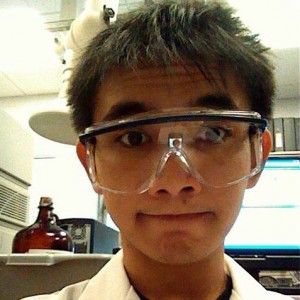By Mike Pablo
“I want you to tell me ten mistakes you’ve made the next time we meet.”
Flashback to my freshman year in college. It was my first time in a research lab, and I was terrified of making mistakes.
I already had high school and the first semester of college under my belt. I hadn’t really considered “doing science” after high school, and didn’t know what kinds of careers it could potentially lead to. Until this moment, I thought I was good at it. And if the university’s orientation events and ‘Introduction to College’ classes taught me anything, it was that freshman year was a great year to try out new things. So, after applying to labs and interviewing with lead scientists, I found myself in Dr. Sunny Zhou’s lab (a.k.a. “Sunnyland”). Looking back, Sunny was very welcoming to totally inexperienced students like me – but that realization would only come later.
I started by assisting one of the graduate students with her experiments, helping her to grow a specific bacterial strain and run a mysterious-looking piece of equipment. The lab was full of unfamiliar things and I definitely panicked a little between understanding what I was helping with, remembering how to use the equipment, and struggling with what I was supposed to know. Going around in confused circles like that, it was hard to get anything done – but I didn’t want to give off the impression that I wasn’t good enough, so I struggled quietly. Eventually, I had a meeting with Sunny to check in and update him on my progress, and my nerves probably showed in my face. Luckily, he told me to make mistakes.
“What?”
Getting a go-ahead to make mistakes turned out to be really important for me – because doing science in a class and doing science in a lab are entirely different things. I didn’t learn from my classes how to have a backup plan for when things went wrong, or how to choose what experiments to prioritize if I ran low on supplies. Research, where you’re often trying to answer questions no one has asked, rarely works the way you expect the first time you try. Or the second time. Or even the third time. Having a plan helps but, to paraphase Robert Burns, the best-laid plans of mice and men often go awry. Personally, I think it’s very important to make mistakes and know you’ve made mistakes when you’re a beginner in practically anything. In a classroom, you might have a teacher and a textbook explaining where you’ve gone wrong. But in the lab – or real life – you need to be aware of your own mistakes.

Of course, there are exceptions in fields where mistakes are unacceptable, like piloting an aircraft. In those cases, there are options like simulation training, where failure is far less costly. Once you’re experienced (and if you’re like me, you’ve failed quite a bit by then) it’s immensely satisfying to succeed at complicated tasks on a first or second try. Still, when you’re just getting going, I think a list full of mistakes is just as valuable to you as a list of successes. Take care to learn from them, though! I learned a lot about equipment maintenance while working in Sunny’s lab – despite my best attempts, I wound up breaking pieces of equipment from time to time.
A little more than three years later, I left Sunny’s lab with a lot more experience under my belt and my sights set on the University of North Carolina to pursue a PhD. This past year, I’ve started new research projects and tried out many unfamiliar things. I’ve made lots of mistakes, but despite that I’m not afraid of moving forward – and that’s let me succeed in things I never would have imagined back before I went to college. Although I haven’t stopped making mistakes quite yet, they’re coming fewer and further between… I think.
Edited by Temperance Rowell and Anna Chiarella
